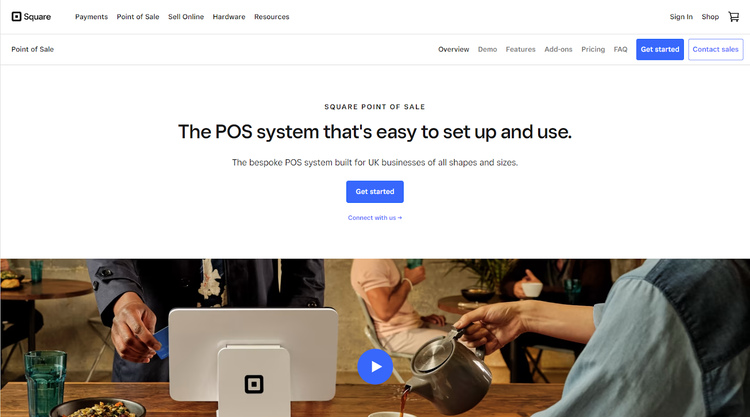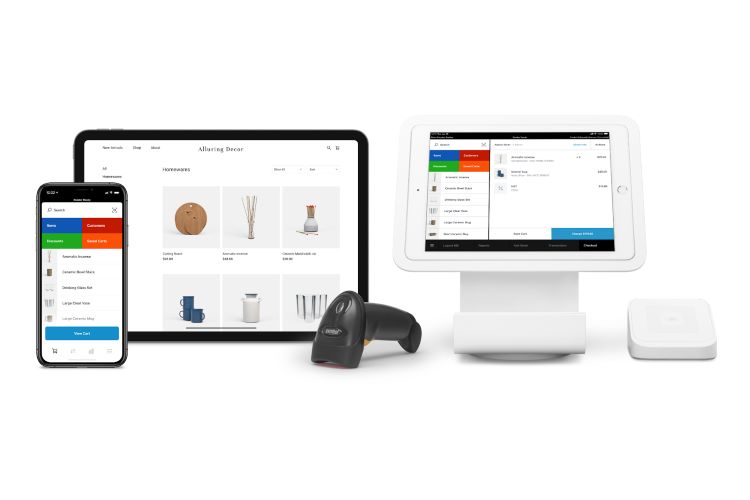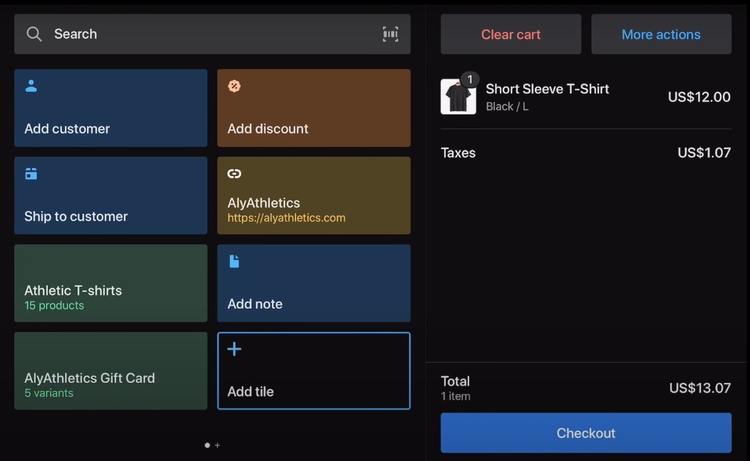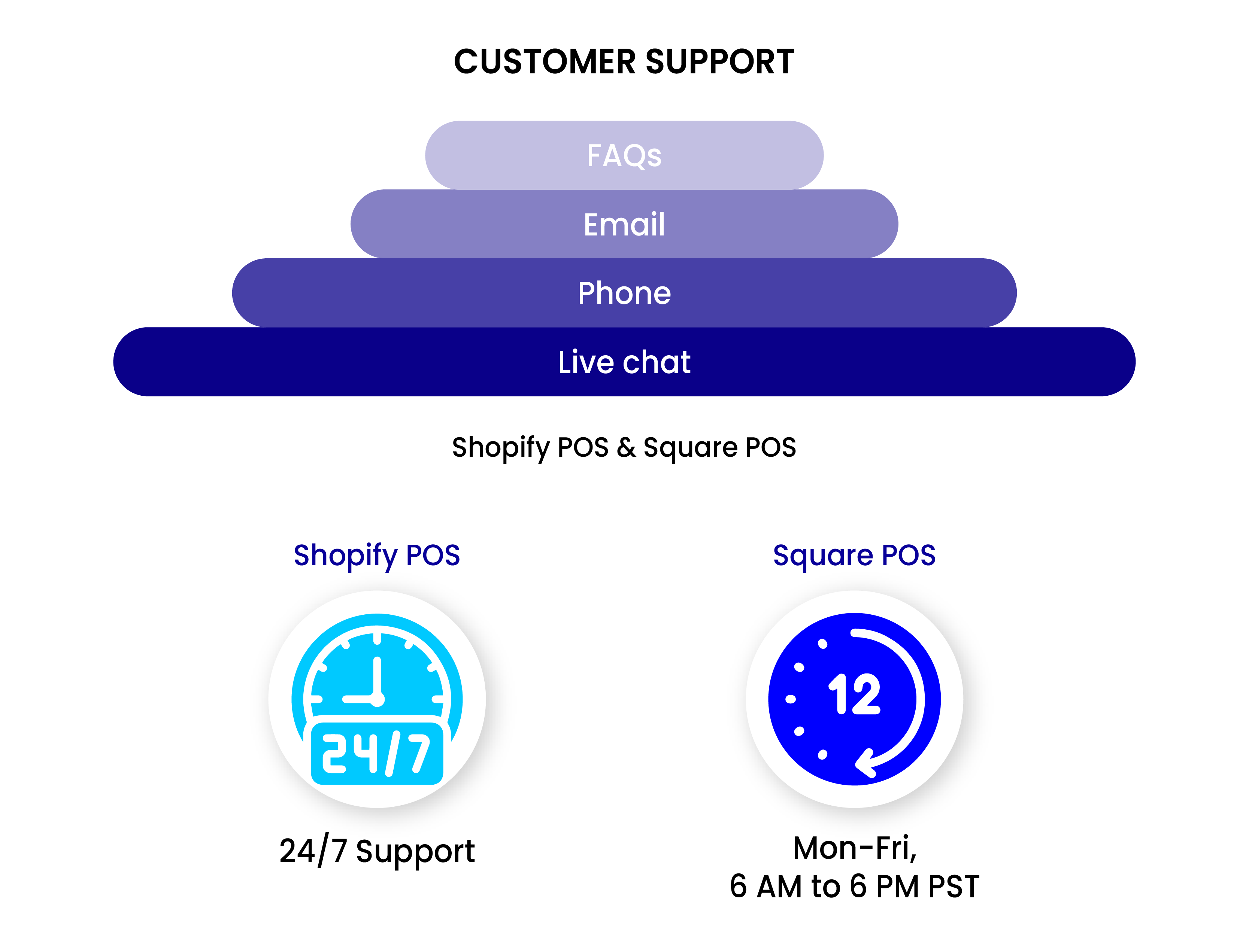Shopify POS vs Square: Which Offers Better POS Capabilities?
This review compares Shopify POS vs Square POS, two popular POS systems that offer a comprehensive set of POS features for businesses of all sizes.
Key takeaways
shopify-pos-integrations
- Shopify POS is perfect for businesses that operate both online and offline, looking for seamless integration between these channels.
- Square POS is ideal for businesses seeking straightforward transaction processing and flexibility. Its simplicity makes it particularly suitable for beginners or businesses with simple needs.
Shopify and Square at a Glance: Key Differences
While both Shopify POS and Square POS offer powerful POS systems for managing sales and transactions, they have distinct differences in their core, strategy, and approach to the POS system.
Shopify POS: Empowering Ecommerce and In-person Retail
If you’ve spent any time in the online retail world, you’ve likely heard of Shopify. As an extension of the well-known ecommerce platform, Shopify POS was built with the idea of merging your online store and physical store into one manageable place. The core philosophy here is unity - providing a platform for managing online and in-person sales, inventory, and customer data, all wrapped up with a neat little bow.
The strategy behind Shopify POS is all about flexibility. No matter if you’re an online seller dabbling in in-person sales, or a retail store with a permanent physical presence, Shopify POS has something for you. The system boasts an extremely user-friendly interface and a wide array of compatible hardware options, all designed to make the process of in-person selling as simple and efficient as possible.

Square POS: Simplifying Transactions and Flexibility
On the flip side, we have Square POS. This system is all about making transactions as easy as pie, with a focus on flexible payment solutions for businesses of all sizes. The Square team had one goal in mind when they started - to make payment processing easy and accessible, especially for small and medium-sized businesses.
Square’s strategy revolves around providing a one-stop-shop solution, bringing together hardware and software. This means you can accept payments using a variety of devices, from your smartphone to a dedicated POS terminal. They also offer tailored solutions for specific industries like restaurants and cafes, making them a versatile choice.

However, today Square evolves into an ecommerce platform offering website builder on Square Online for online merchants to sync your existing eCommerce platform.
So overall, in this comparison, there is not much difference in terms of what Shopify and Square POS can do, but it’s more about which has more advantages.
Shopify vs. Square POS: Infographics

Shopify vs. Square POS: Pros and Cons
Strengths and Weaknesses: Shopify POS
Shopify POS Advantages over Square POS
- Superior Hardware Integration: Shopify POS excels in providing a comprehensive, seamless hardware integration experience. Whether you’re adding a card reader or building a full POS kit with barcode scanners, receipt printers, and cash drawers, Shopify makes the process straightforward. Square also offers hardware integration, but Shopify’s plug-and-play approach is a definite edge for businesses that require customization and ease-of-setup.
- Extensive Third-Party App Ecosystem: While both POS systems offer third-party app integrations, Shopify POS boasts a larger base. This vast selection of apps enhances Shopify’s flexibility and functionality, catering to a wider range of business needs - from inventory management to CRM. Square does offer a number of integrations, but the sheer volume and diversity of Shopify’s app marketplace give it the upper hand.
- User-friendly Interface: The “smart grid” view of Shopify POS simplifies navigation, providing quick access to the most-used apps, discounts, and products. Square also prioritizes user-friendliness, but Shopify’s uncluttered and intuitive layout allows users to reach the features they need with fewer clicks, offering a smoother operation in busy retail environments.
- Efficient Inventory Syncing: If your business operates both online and brick-and-mortar stores, Shopify POS offers the advantage of syncing all inventory within the system, ensuring consistent and accurate stock management. While Square does offer inventory management tools, the synchronization feature in Shopify outperforms its counterpart in terms of seamless integration between online and physical retail channels.
Shopify POS Areas of Improvement
- Offline Functionality: Shopify POS could improve its offline capabilities. During internet disruptions, its functionality can become limited, which is an aspect where Square POS has a slight advantage with more robust offline operations.
Strengths and Weaknesses: Square POS
Square POS Advantages over Shopify POS
- Functional Offline Mode: Square shines in its ability to perform offline transactions seamlessly. This feature is invaluable for businesses that may not always have reliable internet access or are located in areas prone to occasional internet disruptions. Shopify POS also offers offline capabilities, but Square’s robust offline functionality gives it an edge.
- Ease of Setup and Use: Square POS is renowned for its simplicity and ease of setup. With intuitive features and a user-friendly interface, businesses can quickly get started without much technical knowledge or previous POS experience.
Square POS Areas of Improvement
-
Limited Third-Party App Ecosystem: While Square offers integrations with various business software, its range of third-party apps is not as extensive as Shopify POS. This limitation can impact businesses that require specific functionality or more diverse software integrations.
-
Less Comprehensive Hardware Integration: Although Square offers a variety of hardware options, Shopify POS provides a more comprehensive and customizable hardware setup. Businesses that require a more bespoke checkout counter may find Shopify POS more adaptable.
-
Inventory Syncing: If your business operates both ecommerce and brick-and-mortar stores, Shopify POS offers a more seamless syncing of inventory across channels. While Square does offer inventory management features, Shopify’s unified approach simplifies the inventory tracking process, especially for omnichannel businesses.
Shopify POS vs Square POS: Pricing
Square POS vs Shopify POS approach their pricing structures in distinct ways. Let’s dive deep into Shopify’s offerings first:
Breakdown of Shopify POS Pricing
Subscription fees
To use the Shopify POS software, you have to be on one of the following subscription plans.
- The Basic Shopify: $39 per month
- The Shopify: $105 per month
- The Advanced Shopify: $399 per month.
For new merchants, you can try Shopify’s 3-day free trial. This free trial allows you to familiarize yourself with the platform’s functionality without any risk.
After the trial, Shopify offers you a new deal: $1 per month for the initial three months. So rather than paying 39 * 3 = $117 for that period, all you have to pay is $3.
Shopify POS Software Fees
Once you’re a Shopify merchant, you can access two distinct POS software tiers:
- The Shopify POS Lite: $0. The Shopify POS Lite is a free add-on to every Shopify plan, providing essential POS functionality, making it an excellent choice for small businesses looking to minimize their costs.
- The Shopify POS Pro version, available for $89 per month, steps things up a notch, offering advanced features for larger, more demanding retail operations.
If you choose to pay for the Pro version annually, you can benefit from a 10% discount, saving you up to $120 per year.
Transaction fees
Transaction and card processing fees are charged for in-person transactions made through the Shopify Point of Sale (POS) system. The specific fees vary based on your current Shopify plan and whether you use Shopify Payments, which is Shopify’s built-in payment gateway.
Basic Shopify:
- US credit card rates: 2.7% + 0c
- Transaction fees: 2% if you use a third-party payment gateway
Shopify:
- US credit card rates: 2.5% + 0c.
- Transaction fees: 1% if you use an external payment gateway
Advanced Shopify:
- US credit card rates: 2.4% + 0c.
- Transaction fees: 0.5% if you use a third party gateway.
Hardware fees
Shopify offers a wide range of point-of-sale hardware to streamline your POS business. But, there are costs associated with using a Shopify POS hardware.
- Cash Drawers: from $139 to $159.
- Card Readers: $49.
- Receipt Printers: from $289 to $399.
- Barcode Scanners: from $229 to $329.
It’s worth mentioning that you have the flexibility to use third-party hardware devices as long as they meet Shopify’s specifications.

Breakdown of Square POS Pricing
Subscription Fees
Square Point of Sale is designed for businesses that want a versatile POS system that can adapt to any business type or stage and is compatible with a wide range of hardware.
Square POS has 3 main pricing plans:
- Free: No monthly fee; you only pay processing fees for each transaction.
- Plus: Starting from $29 per month. (The Plus plan consists of three more packages — Square for Retail, Square for Restaurant, and Square Appointments.)
- Premium: Custom pricing.
So, as we can see, both Shopify and Square POS don’t charge any monthly fee on the lowest-tier POS plan. However, with Shopify POS Lite, you have to pay for Shopify at least $39 to use their POS software.
In my opinion, Shopify provides a better value for money when you opt for its high-level plan. By subscribing to Shopify POS Pro, you’ll be able to use all of their latest and most comprehensive Point of Sale features. On the other hand, Square Plus splits its offerings into various packages, each with a different price. The cheapest option is $29, but it offers only limited features. So, overall, it ends up being more expensive.
Transaction fees
Here’s a detailed breakdown of the transaction fees:
- In person: When a customer physically taps, dips, or swipes their card, there is a charge of 2.6% plus 10 cents for every transaction. However, for the Plus plan, this fee is reduced to 2.5% + 10¢ per transaction.
- Manually entered: Manually keying in your customer’s card details or using a card on file costs 3.5% + 15¢ per transaction.
- Invoices: Let customers pay invoices online, in person, or from their phone with a credit card, Apple Pay, Google Pay, or ACH bank transfer costs 3.3% + 30¢ per transaction.
Regarding the transaction fees, clearly, Square POS charges a lot higher fees than Shopify POS.

Hardware fees
- Square also offers several hardware options:
- Square Register: A complete point-of-sale with two user-friendly displays and built-in payments for $799 or $39/month over 24 months.
- Square Terminal: An all-in-one credit card terminal for payments and receipts at $299 or $27/month over 12 months.
- Square Stand: An iPad point of sale with integrated payments for $149 or $14/month over 12 months.
- Square Stand Mount: An iPad POS with the versatility to go anywhere in your business for $149 or $14/month over 12 months.
- Square Reader for contactless and chip (2nd generation): A sleek card reader at $59.
- Square Reader for contactless and chip (1st generation): A simple card reader at $49.
The standout point here is Square POS allows installment for merchants buying their hardware.
Overall, there is no big gap in the costs of hardware of Shopify vs Square POS.

The Verdict
Shopify POS is the winner due to its lower transaction fees and optimal suitability for stores with high sales volumes.
Shopify POS vs Square POS: Feature Comparison
Based on the comparison table, both Shopify POS and Square POS offer a wide range of features suitable for small businesses. However, Shopify POS appears to have a slight edge in terms of features that are better suited for small businesses.
Shopify POS provides robust omnichannel selling capabilities, allowing businesses to seamlessly integrate their online and in-store operations. With features like local pickup, local delivery, and the ability to send carts for online purchases, Shopify POS offers greater flexibility and convenience for customers. Additionally, its comprehensive inventory management tools, including purchase orders, demand forecasting, and low stock reports, assist small businesses in efficiently managing their inventory levels and making informed restocking decisions.
Furthermore, Shopify POS offers advanced staff management features, such as manager approvals, unlimited POS staff, and staff roles and permissions. These features enable small businesses to delegate tasks effectively and ensure smooth operations. Shopify’s marketing tools, including product reviews, email marketing, and social media integration, empower small businesses to enhance customer engagement and promote their brand.
The Verdict
Shopify POS is the winner in terms of POS features.
Hardware Integration
Both Square POS and Shopify POS provide robust solutions for hardware integration; however, they differ in several key aspects.
Shopify POS Hardware
The Shopify POS system provides a comprehensive and seamless integration with a variety of hardware components. Users can customize their checkout counter with devices such as card readers, barcode scanners, receipt printers, and cash drawers. One of the unique features of Shopify POS is its plug-and-play hardware, which offers flexibility and ease of use.
Shopify also stands out for its hardware warranty. The company offers a 1-year warranty for its first-party hardware and extends it to 2 years for the Shopify POS Pro. This warranty provides users with peace of mind, knowing that any issues with their hardware would be promptly addressed by the company, with replacements shipped immediately.
Additionally, Shopify provides free shipping and returns on its hardware (for US-based merchants), offering a risk-free trial for businesses.

Square POS Hardware
Square, on the other hand, presents a versatile array of hardware options. From Square Register, a fully integrated POS and payments terminal, to Square Stand, which conveniently turns an iPad into a POS, businesses have a host of options to choose from.
The Square Terminal, a compact, portable device, allows businesses to accept a variety of card payments and print receipts on the go. It can connect wirelessly to the POS, enabling smooth and safe transactions.
The hardware suite from Square also includes Square Reader, an advanced device for accepting chip and contactless payments, including Google Pay and Apple Pay. There’s also the original Square Reader for magstripe, a compact device that can be plugged into a smartphone or tablet for accepting swipe payments.
Square also ensures compatibility with an array of devices and offers a full range of accessories to cater to all POS needs, including cash drawers, barcode scanners, printers, and scales.

The Verdict
Hardware warranty programs make Shopify a winner in this competition.
Comparing Ease of Use of Shopify POS vs Square POS
In terms of ease of use, both platforms offer impressive user experiences, boasting clean and uncluttered interfaces, straightforward navigation, and intuitive controls. However, each has its own key strength.
Shopify POS: Streamlined and Intuitive
Shopify POS has designed its system with the busy merchant in mind. It features a “smart grid” view, allowing users to access their most-used apps, discounts, and products quickly. This function is valuable in a fast-paced retail environment, enabling transactions to be processed rapidly and efficiently.
If you’re operating an ecommerce store along with a physical one, Shopify POS takes away the headache of inventory management by syncing all inventory within the system. Plus, Shopify’s interface is both intuitive and clean, ensuring a seamless user experience. Merchants can access any feature they need within a few clicks from the main dashboard, making it a very user-friendly platform.
Furthermore, Shopify POS is available on both Android and iOS for smartphones and tablets, allowing for versatile usage. In short, Shopify POS is easy to set up and has a user-friendly design, shallow learning curve, and valuable features like customer profile customization.

Square POS: Simplicity Meets Customizability
Square POS is well-known for its simplicity and customizability. Its main dashboard provides everything a business owner needs to manage their operations. It offers a flexible layout where feature widgets can be added, removed, and reordered using drag-and-drop actions. This level of customizability allows each user to create a bespoke dashboard tailored to their business needs.
Like Shopify, Square POS provides an uncluttered and user-friendly dashboard. It’s accessible on both iOS and Android devices and is easily used by those with little to no prior POS experience. Both Shopify vs Square POS offer a free POS app called Tap to Pay, which you can download quickly from your mobile device. This makes it cost-effective and quick solution for in-person selling.
The Verdict
Shopify edges out Square when it comes to ease of use. The Canadian ecommerce platform offers everything merchants need to set up their online store and access its point of sale features even if they are not tech savvy.
Square POS vs Shopify POS: Software Integration Capabilities
When comparing Square POS vs Shopify POS in terms of software/app integration, both platforms bring strong offerings to the table. However, there are certain differences to be aware of.
Square POS Software Integration
Square’s POS system offers a broad spectrum of integration possibilities. From accounting software like QuickBooks and Xero to email marketing software such as MailChimp, Square’s integrations cover a wide array of business operations. They also include ecommerce software like scheduling software, form-builder software, and delivery and order software. Square’s extensive catalog of integration choices makes it an excellent option for businesses aiming to centralize their operations.
Moreover, Square’s API allows users to establish their own custom integrations, providing flexibility and adaptability to unique business needs.

Shopify POS Software Integration
On the other side, Shopify POS stands out for its expansive ecosystem of third-party apps available in the Shopify App Store (8,000+ apps). Shopify has a broader base of integrations, offering compatibility with a plethora of retail-centric software like ACE Retail POS, RetailEdge, SimpleConsign, Cin7 Omni, Afterpay, and many more. This diversity of integrations allows businesses to tailor their Shopify POS to meet their specific requirements and operational processes.
While Square provides a wide range of integrations with flexibility through its API, Shopify excels due to its larger base of third-party app integrations.
In essence, the choice between Shopify and Square in terms of software integration would primarily depend on your business’s specific needs and the apps you currently use or plan to use. It’s always advisable to list out your essential integrations before making a decision to ensure your chosen POS system can fully support your business operations.

The Verdict
Shopify POS is the winner in the sense that it has a larger library of apps and integrations.
Shopify POS vs Square POS: Customer Support
Both platforms offer support in various forms, but their approaches are different, with one standing out as the more favorable option for merchants. Let’s dive into the details.
Shopify POS: 24/7 Accessibility
Shopify POS provides 24/7 customer support via phone, email, and live chat. This round-the-clock availability means that no matter when an issue arises, you can get help promptly. Such accessibility is essential, particularly in the fast-paced world of retail where issues need to be resolved quickly to prevent lost sales and maintain customer satisfaction.
Along with this, Shopify also has a comprehensive Help Center and community forums. Like Square, they offer a rich knowledge base for those who prefer to find answers independently. However, the availability of direct, personalized support at all times gives Shopify a significant edge.
Square POS: Online-Focused Customer Support
Square POS has a strong focus on FAQs and online support, providing a wealth of resources in their knowledge base. They’ve done a great job creating a library of articles and guides to assist users with common questions and concerns. These resources can be particularly beneficial if you’re tech-savvy and comfortable self-navigating through this kind of information.
However, there’s a flip side to this approach. For those who aren’t as comfortable with technology, or simply prefer direct human interaction when they need assistance, Square POS might fall short. While you can contact Square’s Customer Success team via live chat or phone, they don’t have 24/7 support. Their availability is limited to Monday to Friday, 6am to 6pm PST.
In comparison, while Square POS offers a robust online resource center, their limited direct support could leave some merchants feeling frustrated during critical times. This is where Shopify POS shines. Their 24/7 customer support ensures that help is available when you need it most, minimizing potential disruptions to your operations.

The Verdict
Shopify POS is the winner in the competition of customer support.
Shopify POS vs Square POS: Who is the Overall Winner?
In the face-off between Shopify POS and Square POS, the overall winner seems to lean towards Shopify POS. This conclusion comes from a careful consideration of multiple factors. While Square POS also offers commendable features and is particularly noted for its transactional simplicity, its limitations may make it a less optimal choice for some businesses.
Shopify POS or Square POS: Which One is Best For Your Business?
Who should use Shopify POS?
Shopify POS is best suited for:
- Crafters, founder-run shops, solo entrepreneurs with minimal in-person sales
- Online stores venturing into in-person selling for the first time or occasionally.
- Online craft stores branching into pop-up markets
- solo-preneurs hosting occasional in-person sales events.
- Brick-and-mortar stores, pop-up shops, stores with multiple staff members — businesses with regular in-person sales and multiple staff members will find Shopify POS Pro plan offers the advanced features they need.
Who should use Square POS?
Square POS is best suited for:
- Boutique clothing stores, local bookstores, farmer’s market vendors. These are businesses that operate primarily in-person, perhaps with a small online presence.
- Local coffee shops, family-run restaurants, food trucks. Square offers a dedicated POS system for restaurants, including features tailored to the unique needs of the foodservice industry.
- Crafters selling at fairs, independent consultants, small service providers. Square is ideal for small-scale operations where the owner is often the sole staff member.
Shopify POS vs Square: FAQs
Does Square POS work with Shopify?
Yes, Square POS does work with Shopify. Shopify integrates with Square to allow merchants to sell in person using Square’s hardware options. However, it’s important to note that while this integration does exist, it might not offer the same level of cohesion as using Shopify’s own POS system or Square’s system alone.
Which POS system is best: Shopify or Square POS?
The “best” POS system greatly depends on your specific business needs. If your business operates heavily in ecommerce and you require seamless integration between online and physical sales, Shopify POS could be the ideal choice. If simplicity and transaction flexibility are your priorities, then Square POS might be your best bet. Consider factors like your business model, size, and industry before making a decision.
Is Square POS really free?
The answer is No. Square does offer a free version of its POS system which includes features like stock management, sales reports, and customer directories. However, it’s important to note that there may be associated costs for hardware, payment processing fees, and additional features or services. Merchants should review Square’s pricing structure and understand any applicable fees to make an informed decision based on their specific needs.
Which POS system is more user-friendly for beginners: Shopify or Square POS?
Both Square POS vs Shopify POS are renowned for their user-friendly interfaces. However, some beginners find Square’s straightforward transaction processing and simple layout a bit more intuitive. On the other hand, Shopify’s unified sales platform is also easy to grasp, especially for those familiar with the Shopify ecommerce platform.
Can Square POS handle multi-location businesses?
Yes, Square POS can handle multi-location businesses. The system offers features like inventory management, centralized reporting, and multi-location access, enabling businesses with multiple physical locations to effectively manage operations across all sites. This functionality allows for streamlined stock tracking, consolidated reporting, and efficient management of sales and staff across different locations.
Which POS system is more suitable for small businesses: Shopify or Square POS?
Both POS systems cater to small businesses. Shopify POS is particularly beneficial if the business has or plans to have a significant online presence. Square POS is known for its transactional simplicity and has made a name for itself serving smaller businesses, particularly in the food and beverage industry. Both systems are scalable and can grow with your business.
Final Words
Both platforms offer unique features and cater to different business needs. However, while Square POS stands as a worthy adversary, Shopify POS’s robust integration capabilities, user-friendly approach, and data-driven insights ultimately make it the winner of this competition.





